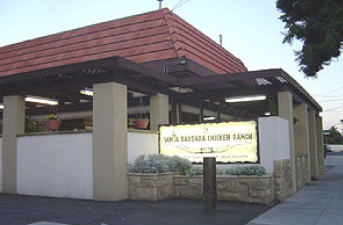
“My business is not tourist based; we have the same customers coming back. If you can keep your employees then you can recognize those customers and provide them a place where the staff knows them,” said Matt Benko, owner of the Santa Barbara Chicken Ranch. Courtesy photo.
Does “buying local” really make a difference? In addition to leaving more money in the community by keeping their profits here, local business owners also cite long-standing employees, customer service, product distinctiveness and community involvement as advantages to “buying local.”
“My business is not tourist based; we have the same customers coming back. If you can keep your employees then you can recognize those customers and provide them a place where the staff knows them,” said Matt Benko, owner of the Santa Barbara Chicken Ranch. “Continuity of staff is critical. It takes a good six months or more to train a cook,” said Benko, who took over the restaurant (and renamed it) when his mother died in 1992. He has one 15-year kitchen veteran, “the first guy my mom hired,” and many other veteran staffers.
Blue Booth, owner of Vices and Spices for 28 years, also emphasized the importance of staff continuity. “One of the things that we do is we’re really focused on real personalized attention. The way we can accomplish that is having the same staff over a long period of time.”
At least 10 of the 30 Chaucer’s Book’s employees have been there more than 10 years, said Mahri Kerley, who in November will celebrate her 29th year as the bookstore’s owner. The staff has undergone extensive training, she said, and “it’s not an easy thing to do.”
Product distinctiveness is another advantage noted by local business owners. “The main thing that sets us apart is that we use mesquite charcoal and only charcoal,” said Benko. It’s cheaper and easier to use gas but the taste isn’t as authentic. Comparing chains such as Taco Bell to local Mexican restaurants, “the spiciness, the flavor goes away as you try to appeal to a lot more people. They blandify it.” But restaurant owners get better quality food when they say, “this is my product” and don’t try to appeal to the masses, said Benko.
While large chain bookstores have enough space to “hold dances in their aisles,” said Kerley, “in almost any section you can think of, I think we’ve got a much better selection than you’ll find in the chains. I like to think the whole store is distinct.”
Being customer-service oriented is another advantage cited by Kerley. ” We can get pretty well anything by special order.” She also points out that Chaucer’s customers do not prepay for special orders.
A personalized touch is important, said Chris Martin, co-owner of Mojo Coffee in Goleta, who trains employees to be themselves and “not be a certain way that the corporations are programmed into teaching their employees.”
Benko also mentioned flexibility as a selling point. “Local restaurants can do things that national chains can’t do. If somebody says ‘This isn’t what I ordered,’ you have the ability to just give them what they want. Whereas (with) a national chain, it’s much harder for them to do that. They have to be more concerned with theft, because they’ve got this on a grand scale.”
Martin also mentioned flexibility in dealing with both employees and customers as an important local business advantage. Six of his 10 employees have been with Mojo from the beginning, and the only reason the four others left is “because they graduated. It’s just a whole better working relationship.”
All of the local business owners mentioned the importance of giving back to the community by providing donations and discounts to schools and other nonprofit groups. “I donate and get involved as much as I can,” said Martin, who has adopted two local elementary schools and a local high school through the County’s “Adopt a School Program.”
“I give gift certificates to every school and church that asks,” said Benko.
While the intangible benefits to the community such as charitable support and customer service are difficult to quantify, in an analysis of local merchants versus chain retailers in the Austin, Texas, area, Civic Economics found that “local merchants generate substantially greater economic impact than chain retailers.” In fact, the study found that for every $100 in customer spending at a national chain, “the total economic impact was only $13, while that same amount spent with a local merchant yields more than three times the local economic impact ($45).”
Other than the Civic Economics study, however, there has been very little objective, fact-based analysis of whether or not “buying local” really makes a difference in a community.
In some areas there are tax incentives given to attract large retailers, but that doesn’t appear to be the case here. “If they have a business and they sell out of that building, the sales tax is going to that area, regardless of whether it’s a huge corporation or not,” said Brian Richard, head of property tax for Santa Barbara County.
The Four Seasons Biltmore Hotel, Sak’s, Trader Joe’s, Sears and Borders were all mentioned by the Santa Barbara Chamber of Commerce’s Steve Cushman as being very active in the business community.
Costco is also active, said Mike Edwards of the Goleta Valley Chamber of Commerce. Barbara Keyani, spokesperson for the Santa Barbara School District, also lauded Costco for its generosity.
Also citing the community support of larger corporations was Judy Hawkins, development director for Women’s Economic Ventures, a local, nonprofit organization dedicated to helping women entrepreneurs. “We are very lucky to have quite a bit of very generous corporate support.”
Ultimately the uniqueness of this area may be what keeps local businesses thriving, despite increased competition from chains.
“In my experience, Santa Barbara is different from a lot of places,” Benko said. “People are willing to go to Farmer Boy’s over Denny’s, even though (Denny’s is) right across the street. I think Santa Barbara people almost actually resist (the chains) because they don’t want it to become L.A.”
Originally published in South Coast Beacon on August 7, 2003.



